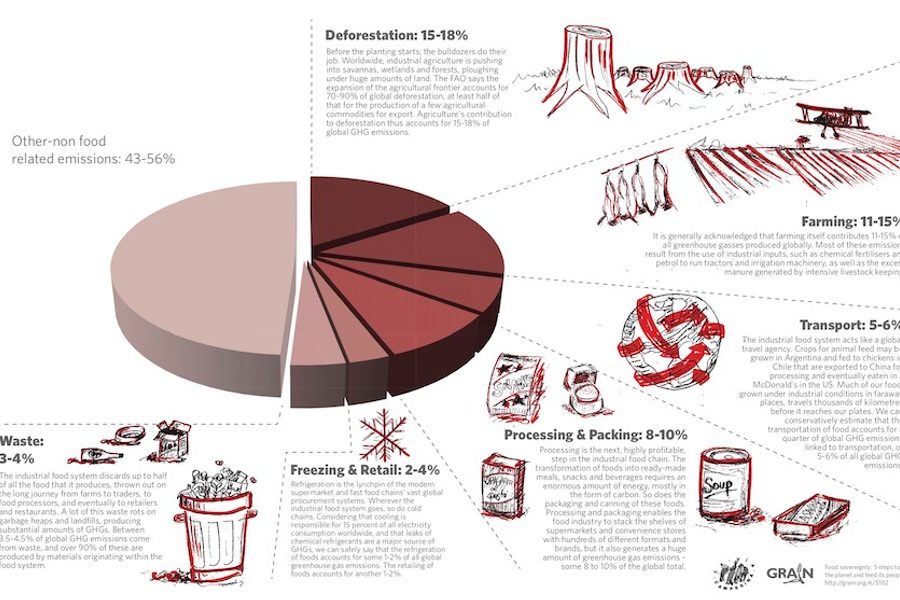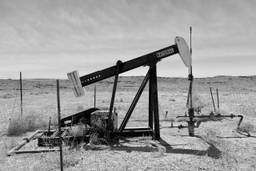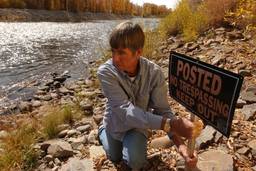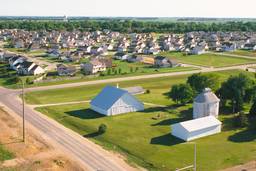Regenerative, Organic Agriculture is Essential to Fighting Climate Change
Ronnie Cummins

The climate emergency is finally getting the attention of the media and the U.S. (and world) body politic, as well as a growing number of politicians, activists and even U.S. farmers.
This great awakening has arrived just in time, given the record-breaking temperatures, violent weather, crop failures and massive waves of forced migration that are quickly becoming the norm. Global scientists have dropped their customary caution. They now warn us that we have to reduce global emissions, by a drastic 45%, over the next decade. If we don’t, we’ll pass the point of no return — defined as reaching 450 parts per million or more of CO2 in the atmosphere — sometime between 2030 and 2050, at which point the climate crisis will morph into a climate catastrophe. That’s when the melting polar ice and Arctic permafrost will trigger catastrophic sea rise, fueling deadly forest fires, climate chaos, crop failures, famine and the widespread disintegration of society as we know it.
To prevent such an outcome, most people now understand that we must quickly move to renewable forms of energy and reduce our fossil fuel emissions as much as possible. But it’s far less widely accepted that energy conservation and renewables can’t do the job alone.
Alongside the massive political and economic campaign to move to 100% (or nearly 100%) renewable energy as soon as possible, we must put an end to the massive emissions of our corporate-dominated food and farming system and start drawing down and sequestering in our soils and forests billions of tons of “legacy” CO2 from the atmosphere, using the enhanced photosynthesis of regenerative farming, reforestation and land restoration.
“Regenerative agriculture” refers to farming and grazing practices that, among other benefits, reverse climate change by rebuilding soil organic matter and restoring degraded soil biodiversity. This results in both carbon drawdown and improved water infiltration and storage in soils.
Regenerative practices include:
• Reduction or elimination of tillage and the use of synthetic chemicals
• Use of cover crops, crop rotations, compost and animal manures
• Integrating animals with perennial and annual plants to create a biologically diverse ecosystem on the farm
• Grazing and pasturing animals on grass, and more specifically using a planned multi-paddock rotation system
• Raising animals in conditions that mimic their natural habitat
If regenerative food, farming and land use — which essentially means moving to the next stage of organic farming, free-range livestock grazing and eco-system restoration — are just as essential to our survival as moving beyond fossil fuels, why aren’t more people talking about this? Why is it that moving beyond industrial agriculture, factory farms, agro-exports and highly-processed junk food to regenerating soils and forests and drawing down enough excess carbon from the atmosphere to re-stabilize our climate is getting so little attention from the media, politicians and the general public?
Our collective ignorance on this crucial topic may have something to do with the fact that we never learned about these things in school, or even college, and until recently there was very little discussion of regeneration in the mass media, or even the alternative media.
But there’s another reason regeneration as a climate solution doesn’t get its due in Congress or in the media: Powerful corporations in the food, farming and forestry sector, along with their indentured politicians, don’t want to admit that their current degenerate, climate-destabilizing, “profit-at-any-cost” production practices and business priorities threaten our very survival.
And government agencies are right there, helping corporate agribusiness and Big Food bury the evidence that these industries’ energy-intensive, chemical-intensive industrial agricultural and food production practices contribute more to global warming than the fossil fuel industry.
The U.S. Environmental Protection Agency (EPA) and the U.S. Department of Agriculture (USDA) repeatedly claim that industrial agriculture is responsible for a mere 9% of our nation’s greenhouse gas emissions. As the EPA explains, greenhouse gas (GHG) “emissions from agriculture come from livestock such as cows, agricultural soils and rice production.”
After hearing this 9% figure regurgitated over and over again in the media, most people draw the conclusion that food and farming aren’t that important of a factor in global warming, especially when compared with transportation, electricity generation, manufacturing and heating and cooling our buildings.
What the EPA, USDA, Big Ag, chemical, and food corporations are conveniently hiding from the public is that there’s no way to separate “U.S. agriculture” from our “food system” as a whole. Their faulty math (i.e. concealing food and farming emissions under the categories of transportation, manufacturing, etc.) is nothing but a smokescreen to hide the massive fossil fuel use and emissions currently belched out by our enormously wasteful, environmentally destructive, climate-destabilizing (and globalized) food system.
USDA and EPA’s nine-percent figure is ridiculous. What about the massive use of petroleum products and fossil fuels to power U.S. tractors and farm equipment, and to manufacture the billions of pounds of pesticides and chemical fertilizers that are dumped and sprayed on farmlands?
What about the ethanol industry that eats up 40 percent of our chemical- and energy-intensive GMO corn production? Among other environmental crimes, the ethanol industry incentivizes farmers to drain wetlands and damage fragile lands. Taking the entire process into account, corn production for ethanol produces more emissions than it supposedly saves when burned in our cars and trucks.
What about the massive release of carbon dioxide, methane, and nitrous oxide from factory farms and the GMO, monocrop industrial grain farms that supply these feedlots and CAFOs with animal feed?
What about the methane emissions from the fracking wells that produce the natural gas that is used in prodigious amounts to manufacture the nitrogen fertilizer dumped on farmlands — fertilizer that then pollutes our waterways and creates oceanic dead zones as well as releasing massive amounts of nitrous oxide (300 percent more damaging than even CO2) into our already oversaturated atmosphere?
What about the 15-20 percent of global fossil fuel emissions that come from processing, packaging (most often in non-recycled plastic), refrigerating and transporting our highly processed (mainly junk) food and agricultural commodities on the average 1,500 miles before they reach the consumer?
What about the enormous amounts of GHG emissions, deforestation and ecosystem destruction in the international supply chain enabling Big Box stores, supermarket chains and junk food purveyors to sell imported cheap food, in many cases “food-like substances” from China and overseas to undernourished U.S. consumers?
What about the enormous emissions from U.S. landfills where wasted food (30−50 percent of our entire production) rots and releases methane, when it could be used to produce compost to replace synthetic fertilizers?
A more accurate estimate of GHG emissions from U.S. and international food, farming and land use is 44-57 percent, not the 9 percent, as the EPA and USDA suggest.
We’re never going to reach net zero emissions in the U.S. by 2030, as the Green New Deal calls for, without a profound change — in fact a revolution — in our food, farming, and land use practices.

I hope you found this article important. Before you leave, I want to ask you to consider supporting our work with a donation. In These Times needs readers like you to help sustain our mission. We don’t depend on—or want—corporate advertising or deep-pocketed billionaires to fund our journalism. We’re supported by you, the reader, so we can focus on covering the issues that matter most to the progressive movement without fear or compromise.
Our work isn’t hidden behind a paywall because of people like you who support our journalism. We want to keep it that way. If you value the work we do and the movements we cover, please consider donating to In These Times.



